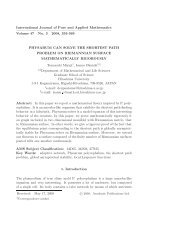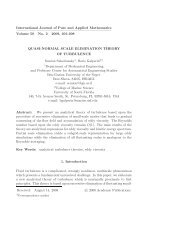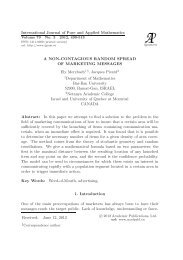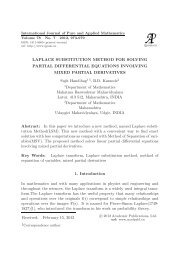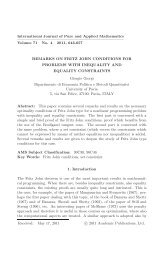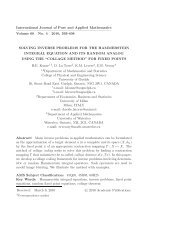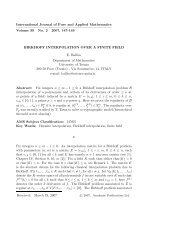WHY DO BOOMERANGS COME BACK? Yutaka Nishiyama ...
WHY DO BOOMERANGS COME BACK? Yutaka Nishiyama ...
WHY DO BOOMERANGS COME BACK? Yutaka Nishiyama ...
Create successful ePaper yourself
Turn your PDF publications into a flip-book with our unique Google optimized e-Paper software.
336 Y. <strong>Nishiyama</strong><br />
Jearl Walker (1979, [3]), both the theory and technique have progressed to a<br />
large extent, and it can now be said to be very near completion (<strong>Nishiyama</strong>,<br />
2002, [5]). In this article, I put forward explanations focusing on reasons why<br />
boomerangs fly back.<br />
There are three commonly perceived causes as to why a boomerang comes<br />
back:<br />
1. Because it is crescent shaped<br />
2. Wind power forces it back<br />
3. Follows the same principle as the curving of a spinning baseball<br />
First and foremost, it is a misconception to believe that a boomerang flies<br />
back because it is shaped in a crescent form. A look at the boomerang models<br />
that are presently popular should explain why. There are boomerangs in the<br />
market that have three or four wings. There are even some that are shaped<br />
like a kangaroo or seagull. There are all constructed to allow them to come<br />
back to the thrower. The issue of whether all these can be called boomerangs<br />
often comes under debate. For a cultural anthropologist, a crescent-shaped<br />
object would constitute a boomerang regardless of whether it comes back to<br />
the thrower; a natural scientist, on the other hand, would call any object that<br />
come back to the location of the thrower a boomerang regardless of the shape<br />
or number of wings.<br />
Second, that a boomerang comes back due to the presence of wind is also a<br />
misconception. For this, it is enough for one to understand that a boomerang<br />
will come back even inside a room where there is no wind. Wind is not a direct<br />
cause for its coming back. It is the presence of air and not wind that causes a<br />
boomerang to come back. It will return as long as there is air present.<br />
The third and final supposed cause, namely that the curve principle causes<br />
the return, is also a misconception. When a baseball is made to spin with<br />
force at the time it is thrown, it either curves or shoots, causing a horizontal<br />
change in the path. This is called the Magnus Effect after the name of its<br />
discoverer. According to the work of Shinji Sakurai [1], a curveball thrown at<br />
the initial velocity of 30 m/second will reach the home base 18 m away with<br />
a horizontal shift of 40 cm. This change in direction by the Magnus Effect is<br />
extremely small. The protagonist in the comic book Kyojin no Hoshi (The Star<br />
of Giants) is shown throwing a baseball from inside a room and catching it on<br />
its way back, but this is pure imagination.



